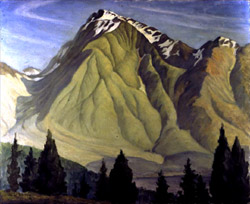John & Katharine Maltwood Collection
| View the Collection |
History of the Collection |
John & Katharine Maltwood |
Information Resources |
Background Maltwoods as Collectors Cultural Context The Arts and Crafts Movement in Victoria
The Collection Museum at "The Thatch" Notable B.C. Artists in the Maltwood Collection - Introduction - Emily Carr - William Percy Weston - Charles John Collings - Ina D.D. Uhthoff - Hildegarde Wyllie - Daisy R. Swayne & Emily Schofield - Elizabeth Duer - Barbara Woodward - Stella Langdale History of the Maltwood Collection (ppt 14.6 MB)
About Us Contact Us Visit Us Site Map

Notable B.C. Artists in the Collection - W.P. Weston | ||||
Trained in London, William Percy Weston came to Vancouver in 1909 to fill the position of art teacher at the King Edward High School. He soon became involved in what little artistic life there was in Vancouver, exhibiting with the B.C. Society of Fine Arts which he joined in 1910. In 1914 Weston moved to the new Provincial Normal School where he taught until his retirement in 1946. His early works were essentially conservative and owed much to the English Romantic landscape tradition. However, he soon realized the Canadian landscape demanded a new strength and vigour to express "its epic quality, its grandeur, its natual beauty."77 By the 1920's he began to capture the vital forces of nature in a new linear, spatial and decorative style. Compositions were simplified, detail was reduced, and solidly moulded and sculpted forms were inroduced. This strong sense of design in his mature style was influenced by the motifs of Art Nouveau, more contemporary Art Deco trends and Japanese pattern.
Katharine Maltwood aquired two works by Weston dating from the period after his retirement when the range of his sketching trips had broadened to include the Okanagan Valley, the Kootenays and the Yukon. In Arbutus Tree, from 1947, a single clawing tree spreads out in rich glowing tones above a cool blue sea and faint mountain skyline beyond. With a linear decorative design and bold clarity of form he creates a striking image of coastal trees. Five years later the landscape Slocan Lake, Cascade Mountains near Denver, B.C.78 was purchased. The lofty mountains, depicted in icy luminous tones, show Weston's reverence for "the overwhelming preponderance of nature" which he felt so outscaled the human element.79 He was particularly fond of studying the sculptural forms and snow patterns of mountains peaks and would often use binoculars to help him clearly define the terrain.80 Although not interested in the theosophy of his contemporaries, Weston's direct manner successfully captured the rugged splendour and the awesome lonely spirit of the Province's scenery.
All content on this page is copyright © 7 February, 2006 |
||||

